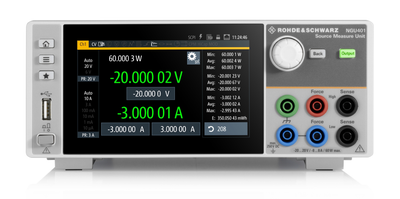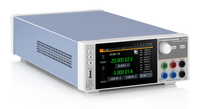Presupuesto Rápido: Rohde & Schwarz NGU401 (3639.3763.03)
Rohde & Schwarz NGU401 (3639.3763.03)
Modelo
NGU401 (3639.3763.03)Familia de productos
LCR / Impedance AnalyzersFabricante
Rohde & SchwarzLos modelos configurados tienen las siguientes opciones:
LCR / Impedance AnalyzersSemiconductor Test EquipmentPermítanos ayudarlo con su configuración exacta
Utilice "Presupuesto Rápido" y nos pondremos en contacto con usted y le cotizaremos para su necesidad exacta.
También puede ponerse en contacto, si lo prefiere, y nuestros expertos podrán orientarlo con la aplicación y la solución de adquisición adecuadas para este producto.
Especificaciones clave
Lo sentimos pero no disponemos actualmente de ninguna información sobre Especificaciones clave para este producto en línea.
Si desea más información, póngase en contacto y un miembro de nuestro equipo le atenderá.
Vista general del producto
The two-quadrant NGU201 and the four-quadrant NGU401 provide up to 60 W of output power and sink power, respectively. The channels are floating, galvanically isolated and protected against overload and short circuits.
With six measurement ranges for current and a resolution of up to 6 ½ digits when measuring voltage, current and power, the NGU source measure units are perfect for characterizing devices that work from extremely low power consumption to high currents in the ampere range. Using ammeters with feedback-amplifier technology increases accuracy and widens the sensitivity down to the nA range. With an acquisition rate of up to 500 000 samples per second, even extremely fast variations in voltage or current can be captured. The instruments provide fast load recovery time of < 30 μs combined with minimum overshoot even during a demanding load change.
The linear design of the output stages allows the NGU source measure units to operate as a source and sink with minimum residual ripple and noise. The two-quadrant NGU201 source measure unit is a new member in the family of wireless communications test instruments, mainly designed to supply devices under test with extremely low sleep currents, such as Bluetooth® low energy devices.
| Key Features |
| Two/four quadrants: operates as source and sink |
| High speed data acquisition (FastLog function) |
| Voltage priority and current priority mode |
| High-capacitance mode |
| Intuitive, price-transparent online product configurator |
| Benefits | |
Two/Four Quadrants: operates as source and sink (Simulates batteries or loads) | The two/four- quadrant architecture of these source measure units allows them to function both as a source and a sink to simulate batteries or loads. The SMU automatically switches from source mode to sink mode as soon as the externally applied voltage exceeds the set nominal voltage With its four-quadrant architecture, the NGU401 can supply positive or negative voltages or currents and can act as a source or sink in both polarities. |
High Speed Data Acquisition (FastLog function) | The NGU source measure units offer the FastLog function to capture voltage and current measurement results. This data can be stored on an external USB storage device or transferred to an external PC via USB or LAN. With an acquisition rate of up to 500 ksample/s, voltage and current results are available every 2 μs. |
Voltage Priority and Current Priority Mode (Optimized for Voltage/Current Regulation) | In voltage priority mode, fast voltage regulation provides short recovery times of less than 30 μs. Current regulation is designed to be somewhat slower to avoid oscillation. When precise and quick current regulation is desired, the NGU source measure units can be operated in current priority mode. Optimized for fast current regulation (load recovery time < 50 μs), this mode allows tasks such as LED testing, which are sensitive to even short current spikes. |
High Capacitance Mode (Compensate capacitors) | Quite often in a typical measurement configuration, there is capacitance at the input of the DUT. Connecting the power supply with leads causes low pass behaviour from the leads and capacitance. In high-capacitance mode, NGU source measure units compensate for the capacitance and display the current directly at the DUT. |
Fast Load Regulation (Handles fast load changes) | Consumer electronics such as mobile phones and IoT devices require very little power in sleep mode. However, the current increases abruptly as soon as the device switches to transmit mode. A power supply for such DUTs must be able to handle load changes from a few nA to the ampere range without creating voltage drops or overshoots. |
| Easy to Use | The NGU and other instruments for the Essential portfolio can now be configured online, providing the following benefits: ▪ User-friendly and easy to navigate configurator |
| Specifications | |||||
NGU Source Measure Units | |||||
| Model Overview | |||||
| Model | Order Number | Output Channels | Max. Output Power | Output Voltage Per Channel | Output Current per Channel |
| NGU201 | 3639.3763.02 | 1 | 60 W | 0 V to 20 V | ≤ 6 V: 8 A > 6 V: 3 A |
| NGU401 | 3639.3763.03 | 1 | 60 W | -20 V to +20 V | ≤ 6 V: ±8 A > 6 V: ±3 A |
| NGU411 | 3639.3763.04 | 1 | 20 W | -20 V to +20 V | ≤ 10 V: ±2 A > 10 V: ±1 A |
| Specifications | ||
NGU Source Measure Units | ||
| Model Overview | ||
| Model | Order Number | Description |
| NGU201 | 3639.3763.02 | Two-quadrant source measure unit |
| NGU401 | 3639.3763.03 | Four-quadrant source measure unit, 60 W |
| NGU411 | 3639.3763.04 | Four-quadrant source measure unit, 20 W |
| Accessories | Included: Power Cable Quick Start Guide | |
| Options for NGU201 | ||
| NGU-K103 | 3662.9335.02 | Digital trigger I/O |
| NGU-K104 | 3663.0390.02 | Digital voltmeter function |
| NGU-B105 | 3661.0763.02 | IEEE-488 (GPIB) interface |
| NGU-K106 | 3663.0625.02 | Battery simulation |
| Options for NGU401/NGU411 | ||
| NGU-K103 | 3662.9335.02 | Digital trigger I/O |
| NGU-B105 | 3661.0763.02 | IEEE-488 (GPIB) interface |
| System Components | ||
| HZN96 | 3638.7813.02 | 19" rack adapter, 2 HU |
¿No encuentra lo que está buscando?
Póngase en contacto con nosotros






